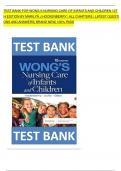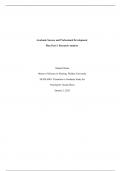Exam (elaborations)
TEST BANK FOR WONG S NURSING CARE OF INFANTS AND CHILDREN 12TH EDITION BY MARILYN J HOCKENBERRY | ALL CHAPTERS | LATEST QUESTIONS AND ANSWERS| BRAND NEW| 100% PASS
Chapter 01: Perspectives of Pediatric Nursing Hockenberry: Wong’s Nursing Care of Infants and Children, 12th Edition MULTIPLE CHOICE 1. What is the major cause of death for children in the United States? a. Heart disease b. Childhood cancer c. Injuries d. Congenital anomalies ANS: C U...
[Show more]












